

| Trade log-in: | HERE | |
| Get password | Forgot password | ||

2015.3 | 2015.2 | 2015.1
2014.3 | 2014.2 | 2014.1 | 2013.3 | 2013.2 | 2013.1 | 2012.3 | 2012.2 | 2012.1
2011.3 | 2011.2 | 2011.1 | 2010.3 | 2010.2 | 2010.1 | 2009.3 | 2009.2 | 2009.1
2008.3 | 2008.2 | 2008.1 | 2007.3 | 2007.2 | 2007.1 | 2006.3 | 2006.2 | 2006.1
2005 | 2004 | 2003 | 2002 | 2001 | 2000
In this issue, as we look at the bounty of Burma and the roundup of research, let’s take a moment to dig deep for Pakistan.
Spinel continues its rise in popularity and intrigue in the gemstone market. Many collectors are on the hunt for the elusive 10+ carat red spinel, which is hard to find because most crystals come in smaller sizes, leading to faceted stones weighing mainly under 5 carats. It seems even harder to track down a fine 10-carat red spinel than it is to find a 10-carat ruby these days. The rarity of these spinels is becoming more apparent as collectors branch out in search of the next fine gem to add to their collection.
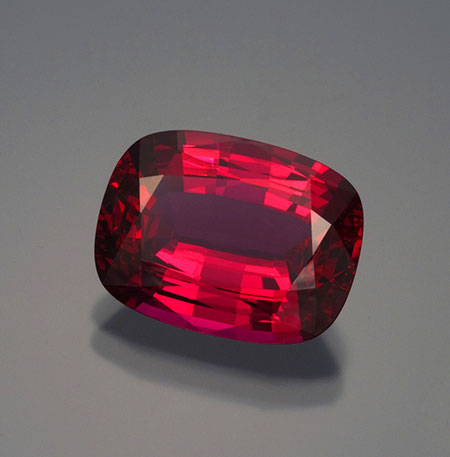 |
| Rare red. 10.21-carat cushion red spinel from Burma, 15.9 x 12.01 x 6.67 mm. Ask for Inv. #18576. (Photo: Wimon Manorotkul) |
This month we feature a 10-carat red spinel from Burma with a spectacular red hue and a lot of character. In normal lighting conditions this gem is deep purplish red; under bright lighting or natural sunlight the gem comes alive with a slightly pinkish red hue and a fluorescent glow. The gem has an Gübelin Gem Lab cert from 1993 with its original weight of 15.81 carats. It was recently recut to its current weigh of 10.21 carats to improve cut and brilliance.
Click here to see our inventory of more spinels.
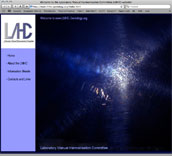 |
Did you ever have a problem remembering which laboratory had posted the Information Sheets of the Laboratory Manual Harmonisation Committee? No more searching through the pages of the member labs: the LMHC now has its own website.
The nine Information Sheets are listed on the website along with their revision dates and a brief description of the content. As the name of the committee suggests, the aim of the group is to standardize nomenclature used in gemological reports issued by the six member laboratories.
On May 25, another trade group, the Gemstone Industry & Laboratory Conference, issued an announcement from the GILC Ruby Committee on the disclosure of lead glass-filled ruby, following months of discussion and final deliberation at Tucson this year. Read the press release here.
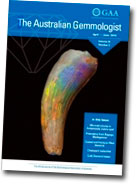 |
Since we’re on the subject of filling, The Australian Gemmologist takes up the subject in a brownish orange-yellow diamond. From the abstract:
EDXRF analyses suggested that Ag, Fe, Ti, AI, Pb, Br are the major trace elements of the coating. The diamond was treated by Pb and Br glass filling, and followed by coating involving Ag and Fe nanoparticles.
Read more and view a photomicrograph at the journal’s website. Other topics of interest in the current issue: “Microstructures observed in Andamooka matrix opal,” “A chatoyant malachite,” and, for the esoterically inclined, “A study of prismatine from Begogo, Madagascar,” which deals with kornerupine.
The GemExpert consultancy of Drs. Henry. A. Hänni and Johannes Hunziker has posted two Gem-A reprints regarding cultured pearls. The first, from Gems & Jewellery, is entitled “How to make a cultured pearl.” The second, from the Journal of Gemmology, is “A short review of the use of ‘keshi’ as a term to describe pearls.”
 |
| Pala International has a lovely collection of faceted pearls, including this black beauty, Inventory #4513. See them all here. (Photo: Wimon Manorotkul) |
[back to top]
First, the good news… Last month, the Trade Development Authority of Pakistan released provisional export statistics for the period of July 2009 through June 2010. The value for the Gems & Jewellery sector increased by nearly 125 percent over the same period during 2008–2009. The value increased from $289 million to $649 million.
  |
| There’s peridot from Pakistan and then Peridot From Pakistan. The natural number above is nearly 37 carats of brilliancy. Inventory #15529. At right, a 1.81-carat Pakistan sphene displays its own brand of brilliance, with a complex of yellow, orange, and green. Inventory #16408. (Photos: Wimon Manorotkul, Mia Dixon) |
Most of that increase appears to be in the form of finished jewelry, according to another set of statistics, Average Unit Price (AUP). Jewelry saw a 126 percent increase in AUP value, while gems increased by 6.76 percent.
The United States, United Arab Emirates, and Afghanistan continue to occupy the top three slots as consumers of Pakistan exports, but the total value of all exports had an incredible 22 percent drop from 2008–2009.
This past spring, the U.S. government announced a partnership with the North West Frontier Province University of Engineering and Technology and the Pakistan Gems and Jewellery Development Company to launch a $600,000 FATA (Federally Administered Tribal Areas) Center of Excellence for Gems and Jewellery.
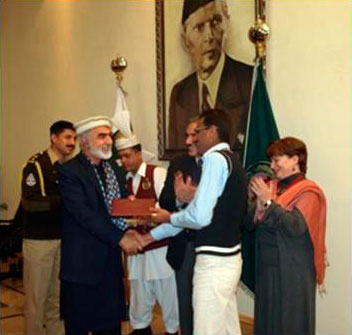 |
| Diplomate. NWFP Governor Awais Ahmad Ghani awards diploma to gemology training graduate. (Photo courtesy U.S. Embassy) |
“The establishment of this Center of Excellence will improve extraction techniques, cutting, polishing, and gemstone identification,” said U.S. Consul General in Peshawar Ms. E. Candace Putnam, according to an April 22 press release.
The Center of Excellence is part of the $750 million support the U.S. government is providing in development assistance to FATA over five years to improve health, education, and infrastructure; develop businesses; and create employment opportunities, according to the release. [back to top]
As for the bad news, Pakistan’s devastating floods have affected more than 15 million people, of which at least 6 million need life-saving emergency assistance, according to Pakistan government estimates reported by the United Nations’ Humanitarian Affairs section on August 18. Relief efforts are encouraging, but…. “Unfortunately, this is only a fraction of what we need to do,” said Martin Mogwanja, the UN Humanitarian Coordinator in Pakistan.
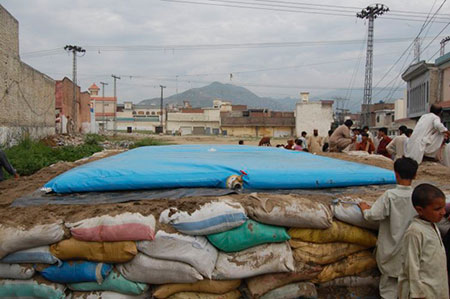 |
| Full bladder. Access to clean water, such as that contained within this MSF water bladder, is crucial to preventing disease. (Photo © Jean-Marc Jacobs/MSF) |
May we suggest supporting relief workers on the ground? The fight against cholera and other waterborne diseases is being done by members of Médecins Sans Frontières/Doctors Without Borders in the Swat Valley. For millennia the people of the Indus have contributed to civilizations; for six decades, the people of Pakistan have dug deep for connoisseurs of colored stones. Dig deep!
[back to top]
More good news: We’ve been notified of an exciting new find of fine-quality tourmaline from a correspondent in Islamabad. The deposit is in the Astore District of Pakistan’s northernmost territory of Gilgit Baltistan. Here’s what he told:
I am based in Islamabad, but Bunji is my home town. Unfortunately at the moment Bunji is cut off from the rest of the North due to flash floods. The two bridges connecting Bunji to the Karakuram Highway’s Bunji Ramghat Bridge and Partab Bridge are broken.
Our main interest was this discovery of the 3rd Century AD rock carving, photos of which are attached with my email. This is a new discovery. The Pakistan Government has a mega hydroelectric power project in Bunji on the River Indus, funded by the World Bank. During the survey these ancient rock carvings were found, and along this the tourmaline deposits were also discovered. My field team has sent me the picture of the rock carving, but not the tourmaline. I have asked them to send me the pictures of tourmaline also. As soon as I get them, I’ll send them to you.
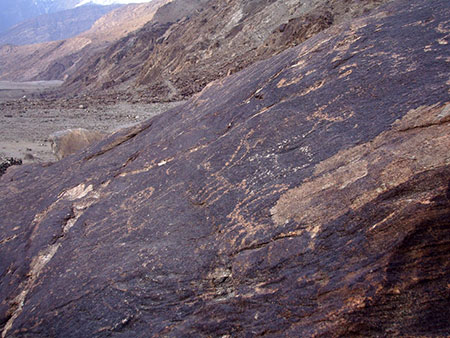 |
| Semiotics in stone. For more on the highway carvings and inscriptions, see this website describing a Pakistani–German project that began surveying the carvings in 1979. The area features an estimated “30,000 petroglyphs and 5,000 inscriptions in more than 10 writing systems,” according to the website, affiliated with Heidelberger Akademie der Wissenschaften. |
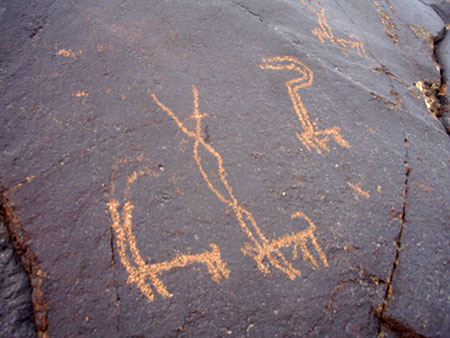 |
Our correspondent told us he’s setting up a new company that “will be arranging field and study trips to Pakistan for gemologists and geologists from all over the world.” We’ll be sure to let our readers know about that. In the meantime, we include here the photos of the petroglyphs and surrounding vistas.
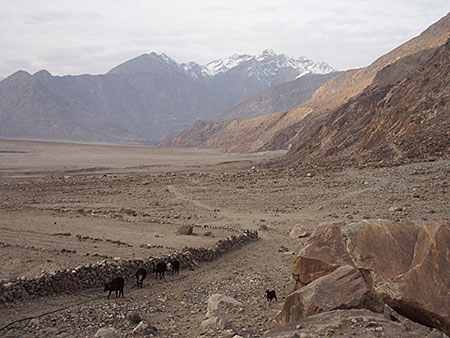 |
| Keep that dogie movin’… A few cattle lumber along as a calf strays from the highway that is host to newly discovered petroglyphs. |
[back to top]
A month ago, as reported to BBC, the “blood diamond” trade oversight method, the Kimberley Process (KP, facilitated via the World Diamond Council), gave the green light to Zimbabwe to resume limited exports of diamonds from the country. The KP suspended exports last November amid allegations that atrocities had been committed by security forces.
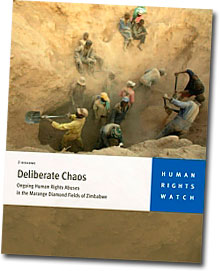 |
| Human Rights watch issued a report June 21 that warned the KP of ongoing abuses. |
Ironically, soldiers who were deployed to remove illegal miners in the diamond fields of Marange, eastern Zimbabwe, themselves began mining by forcing local villagers to dig, according to (United Nations news organ) IRIN in January 2009. “As a soldier, just like most people in this country, I am poorly paid,” one soldier told IRIN, “and my salary can hardly see me through three days of a month. When I get a chance to loot, I grab it without hesitation.”
Last week, Rapaport announced it would continue the trade ban on diamonds from Marange, and that the enterprise would expel members of its network if they sold them. Martin Rapaport himself pointed out that the Zimbabwean companies selling the diamonds (BBC reported $72 million sold since KP lifted its ban) were still sanctioned by the U.S., U.K., and E.U.
On July 21, President Barack Obama signed into law a federal financial reform statute that, amongst its miscellaneous provisions, directs the Securities and Exchange Commission to create rules that address “conflict” materials. Publicly traded manufacturers that use gold, coltan, cassiterite, wolframite or their derivatives would be required to disclose that those minerals are obtained in the Democratic Republic of Congo or neighboring countries.
Search for “conflict minerals” or “sec. 1501” in the text of the law for more detail. [back to top]
Myint Soe, a friend of Pala International, sent us these photographs of an impressive jade boulder that one insider estimates could bring $15–30 million at auction. It was observed on April 23.
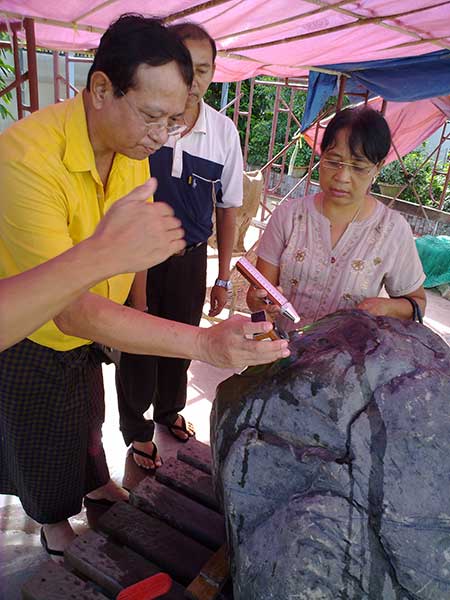 |
| Bolder boulder. Friend of Pala International Han Htun, FGA, and Phyun Phyu Myint inspect the jade boulder. Note: We misidentified Phyun Phyu Myint in our e-mailed newsletter. We regret the error. (Photo: Myint Soe) |
This is 930 kg. of imperial jade. It measures 28" x 20" x 79" in height and hails from Waia Kar Maw, Phakant, Kachin State. It was mined from beneath 600 feet of Kahtar Black soil. The owner is Tun Yadanar Sein Co. Ltd. The floor price for this boulder is 22.5 million euros.
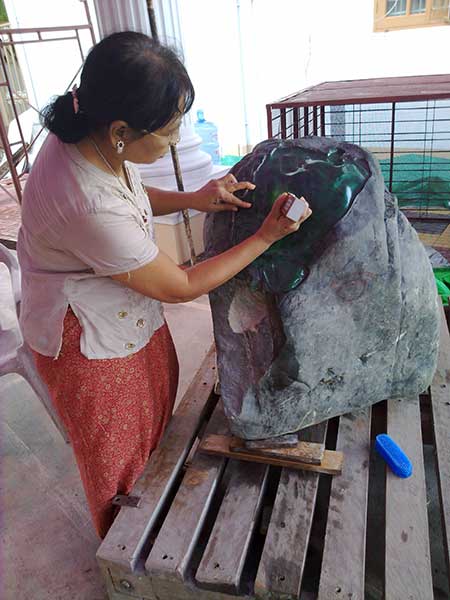 |
| Final exam. Phyun Phyu Myint inspects the jade boulder. (Photo: Myint Soe) |
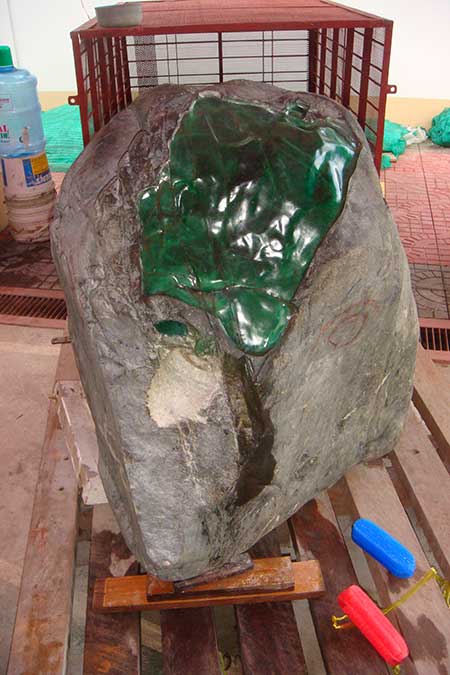 |
| A ton of fun. Jade boulder from Phakant. (Photo: Myint Soe) |
[back to top]
 |
| Mmm… Here’s a 5.25-carat red spinel crystal from Burma, with typical octahedral shape. Inventory #17373. (Photo: Mia Dixon) |
The Union of Myanmar Economic Holdings Limited is holding its 29th Gems & Jade Sale August 20–24 in Yangon.
Among the offerings in the announcement:
We would like to announce that Rough Ruby from Mogok, weighing ( 33.50 ) carats, clear, flawless, transparent and of a red colour, starting price Kyat ( 150 ) million will be on sale. Another Rough Ruby from Mogok, weighing ( 76.00 ) carats, flawless, glass texture, light pigeon blood colour, the reserved price Kyat ( 100 ) million. A Rough Sapphire from Mogok, weighing ( 366.80 ) carats, wax texture, velvet blue colour, star or good cabochon quantity, starting price Kyat ( 100 ) million will be on sale. Magnificent Pink Tourmaline (Rubellite) Crystals with quartz and feldspar in matrix weighing ( 19 ) kilogram, the starting price Euro ( 5 ) million.
Oh, we just happened to have photos of that last item…
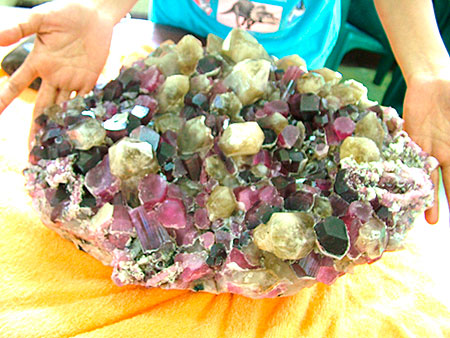 |
| Rich and fruity. Rubellite matrix from Let-Pan-Hla Mine, operated by UMEHL, to be exhibited at the sale this month. The crystals—about 150 in all—are 1–1.5 inches. (Photos courtesy Kyaw Thu) |
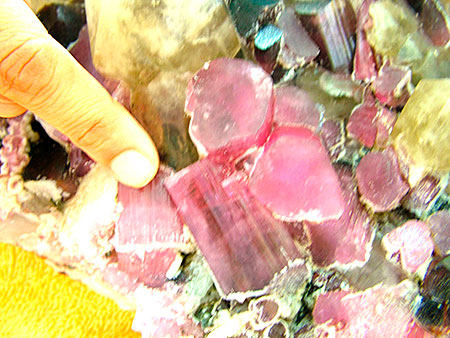 |
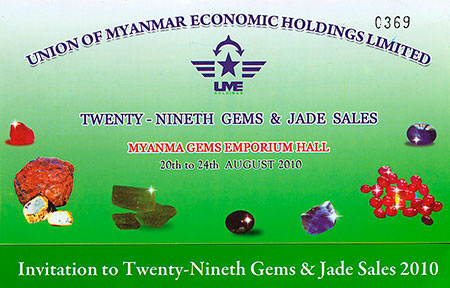 |
[back to top]
— End August Newsletter • Published 8/19/10 —
In this issue of our newsletter we begin Pala International’s 41st year with a new name, Palagems Reflective Index, which comes to us by way of Bill Larson, with a little help from his friend(s). Speaking of friends, we’re indebted to all of you for contributing to what appears in this edition, as well as for the patronage with which you sustain us. Thank you.
Pala International heads to the East Coast later this summer for the trade-only JA New York Summer Show. Stop by to see one of America’s largest selections of fine colored gems.
 |
When: July 25–July 28, 2010
Where: Jacob K. Javits Convention Center
Hours: AGTA Gemstone Section
Sunday, July 25: 9:30 AM – 6:00 PM
Monday, July 26: 10:00 AM – 6:00 PM
Tuesday, July 27: 10:00 AM – 6:00 PM
Wednesday, July 28: 10:00 AM – 3:00 PM
Pala International is in booth 1671. See the JANY website for more information. Visit the Pala International Show Schedule for future events. [back to top]
 |
| Certifiably gorgeous. This 1.03-carat natural ruby from Burma comes with an AGTA cert. Inventory #17917. (Photo: Mia Dixon) |
This year’s East Coast Show will present Bill Larson as its featured exhibitor. Past featured collections have included those of Herb and Monika Obodda, the Sterling Hill Mining Museum, the Harvard Mineral Museum, Seaman Mineral Museum, Dawn Minette, Dan and Dianne Kile, and Gail and Jim Spann, amongst others.
Bill also will speak on Saturday, August 14, at 1:00 p.m., on the topic of “Mining, Minerals & Gems from The Legendary Valley of Rubies, Mogok, Burma.”
Other speakers this year are Bob Jones, Nancy Millard, and Kevin Downey. Nearly 200 dealers, designers, lapidaries, and publishers from the U.S. and abroad will be featured at the show.
What: East Coast Gem, Mineral & Fossil Show
When: August 13–15, 2010
Space: 0083
Where: Better Living Center at the Eastern States Exposition, West Springfield, Massachusetts
 |
| 2-for-1: This Mogok ruby crystal on calcite matrix actually contains a small attached ruby crystal on the side of the larger crystal. See two other views at Palaminerals.com. (Photo: John McLean) |
[back to top]
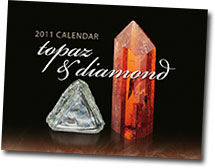 |
As well as stopping by Pala International’s space at the East Coast Show, visit Lithographie (space 0115) and check out the 2011 Calendar from this purveyor of fine books and periodicals on gems and minerals.
The theme this time is “Topaz and Diamond.” The illustration for May is a topaz group from Pakistan’s Shigar Valley, from Bill Larson’s collection, photographed by Jeff Scovil. The 9" x 12" format makes for some pleasurable penciling-in of appointments.
Several other California collectors are represented, including cover stars Jon and Max Sigerman, who provided the macle twinned diamond from their father-and-son collection. Read more about the dynamic duo in this July 5 Marin Independent Journal article. [back to top]
Our readers will be familiar with the photographs of of Harold and Erica Van Pelt. Lesser known is Harold’s work as a masterful carver of quartz—the variety of rock crystal, and the subvariety of agate (a variety of chalcedony).
This month, Southern California’s Bowers Museum presents the first look at the full body of Van Pelt’s 35 years of work in an exhibition entitled “Gemstone Carvings: The Masterworks of Harold Van Pelt.” Images follow, but you’ll want to see this show in person...
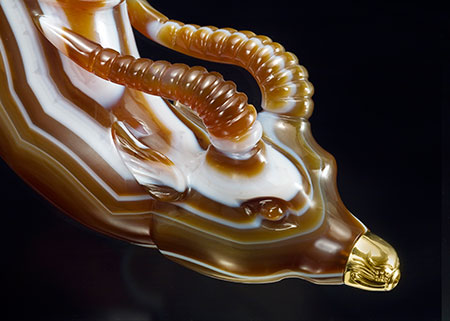 |
| Agate Rhyton by Harold Van Pelt: carved agate drinking vessel with gold capped nose with a hole to restrict the flow of liquid. (Photo courtesy Bowers Museum) |
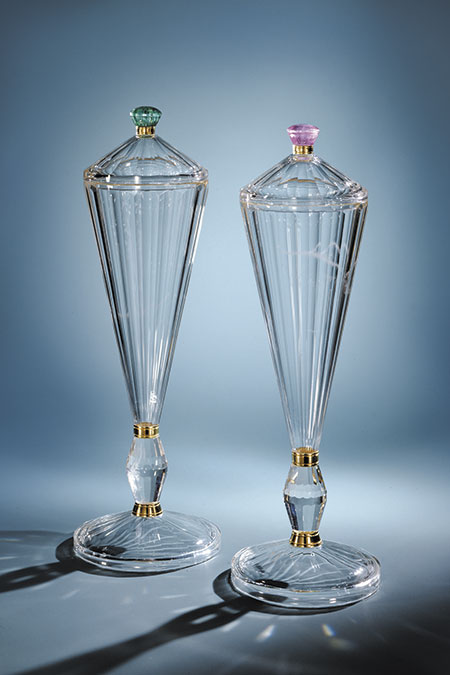 |
| Quartz Twin Vases by Harold Van Pelt: Rock crystal vases measuring 10 ½ in high × 3 in. in diameter at the top and 3 ½ in. at the base. Each vase has 96 facets. The tops of the covers are made of green and pink tourmalines. (Photo courtesy Bowers Museum) |
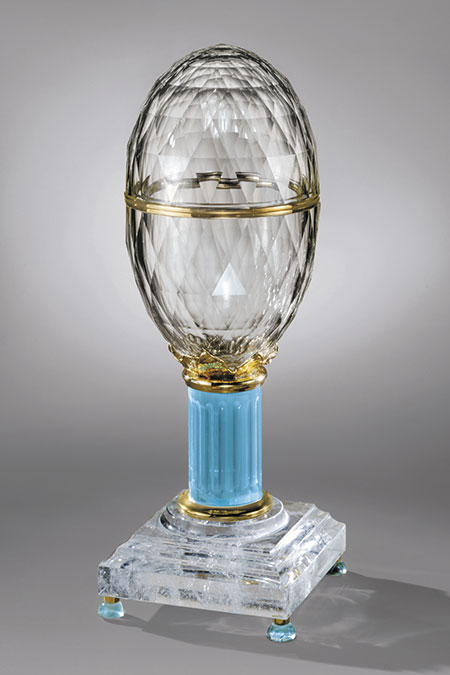 |
| Faceted Quartz Egg by Harold Van Pelt: 8½” h. This hollowed-out quartz egg contains 416 triangular facets and rests on a 363-carat aquamarine pedestal. Its walls are paper thin. (Photo courtesy Bowers Museum) |
The exhibition opened Saturday, July 17, and is on view through May 1, 2011. [back to top]
Green grossular is a pleasant variety of the garnet family. Lighter green hues—often described as mint—glow with a subtle beauty. Gems such as our feature this month seem to have a neon quality, a fluorescence in natural light. Varying amounts of V2O3 & Cr2O3 (vanadium and chromium) account for the intensity of the green.
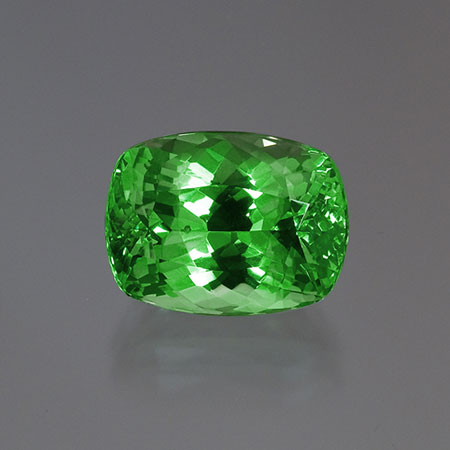 |
| Green Jewel. Mint grossular garnet, 12.04 carats, 14.63 x 11.14 x 8.87 mm., Inventory #18012. (Photo: Jason Stephenson) |
These green jewels are occasionally found in the Merelani Hills of northern Tanzania. Mint garnets under 5 carats are fairly common, but stones over 10 carats are extremely rare, especially with this highly saturated, pure mint color. Its darker, more evergreen brother, tsavorite, is found in Merelani occasionally and further to the north in a similar geologic setting from northern Tanzania into southern Kenya.
Read more about the Merelani deposit here.
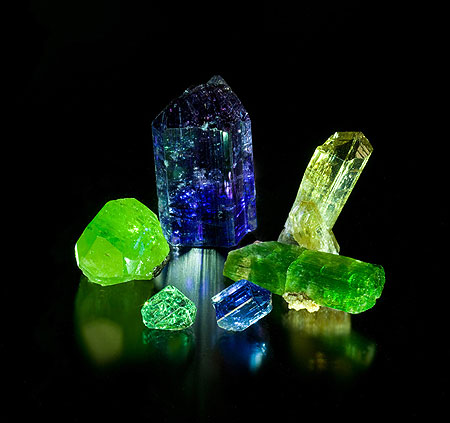 |
| Merelani mix. Clockwise from top center: tanzanite 5.5 x 2.7 cm., yellow zoisite 4.6 x 1.5 cm., tremolite 5.1 x 1.8 cm., tanzanite 1.7 x 1.1 cm., grossular garnet 0.9 x 1.4 cm, diopside 3 x 2.5 cm. From the collection of Bill Larson. (Photo: Jason Stephenson) |
Interested? Select the inventory number above, call, or email us to inquire. [back to top]
One of the interludes in the story of the famous diamond that would be known as the Hope is its 43-year tour of duty in a remarkable setting commissioned by Louis XV: a ceremonial pendant for the Order of the Golden Fleece. Philip the Good, finding himself with too much time on his hands in the late Middle Ages, after doing things like capturing Jeanne d’Arc and uniting Burgundy with Flanders, celebrated by creating a new order, patterned after the Knights of the Round Table. Louis XV was the first king of France to receive the honor of investiture, in 1739. Created a decade later by the king’s jeweler Pierre-André Jacquemin, the ornate pendent was among the loot taken from his grandson-successor Louis XVI’s royal storehouse in 1792, four months before the latter’s horrifying execution.
 |
| Philip the Austere. The founder of the Order of the Golden Fleece is depicted above with the Knight’s typical neck chain—itself not a mean piece of craftsmanship. Louis XV, portrayed in pastel below by Maurice Quentin de La Tour, wears the insignia a year before creation of the ornate, ceremonial setting that would include several jewels of prominence. Successor Louis XVI was portrayed during the year of his ascension wearing his own “lite” version of the pendant. Compare these with images and descriptions from La Confrérie Amicale de la Toison d’Or, which works to “preserve its history and further the aims of the Order.” |
 |
Although many component parts of Louis XV’s precious emblem were recovered, only spotty visual representation of the pendant survived. As indicated by the caption above, a quick survey of portraits of Louis XV and his successor yields Golden Fleece pendants that are, if you will, “black tie” to the ceremonial “white tie” of Jacquemin’s chef d’oeuvre. An 1889 book by C. Germain Bapst, who numbered among the ninth generation of jewelers to the crown, includes a drawing supposedly rendered from a lead cast of the pendant. Then, a hundred years later, an unpublished drawing by Jacquemin himself turned up in Switzerland. Problem is, careful and even casual comparison between the two renderings raised issues of what Jacquemin actually had crafted.
Much study has taken place over the years by various parties to bring us to June 30, 2010, when a reconstruction of the ceremonial Golden Fleece emblem was presented at the site of its 18th century theft: the Garde-Meuble royal, now the Hôtel de la Marine, on Paris’s Place de la Concorde (then, Place Royale).
For a detailed account of the years of detective work that went into the reconstruction, see: Farges F., Sucher S., Horovitz H., Fourcault J.-M. “The French Blue and the Hope: New Data from the Discovery of A Historical Lead Cast,” Gems & Gemology, 45:1 (Spring 2009), 4–19.
 |
| The recreation of Louis XV’s insignia of the Order of the Golden Fleece took three years to complete. (Photo courtesy François Farges, MNHN) |
Dr. François Farges, professor of mineralogy and curator of minerals and gems at the Muséum National d’Histoire Naturelle (MNHN) in Paris, worked for three years with an international team under the supervision of Swiss jeweler Herbert Horovitz to do the meticulous work of recreating a masterpiece. The major elements are:
Most of the other large diamonds were recovered after the theft; thus their replication was not based on speculation. The jewel-encrusted elements, however, such as the Golden Fleece insignia itself, never reappeared. That left over 500 diamonds to be replicated. These were cut from cubic zirconia.
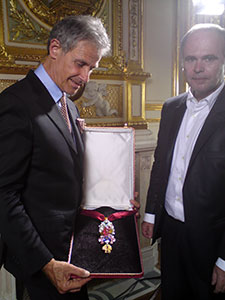 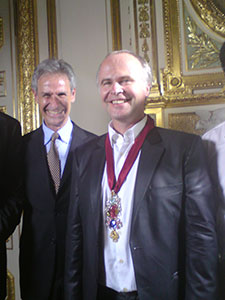 |
| Herbert Horovitz, left and François Farges present the Golden Fleece at the site of its 1792 theft, on the Place Concorde, June 30, 2010. (Photos: C. du Muizon, MNHN) |
We’d love to go on, but all of the details, including names of the artists involved, will be published elsewhere in the not too distant future. The Golden Fleece is available for viewing by appointment at Martin du Daffoy, Bijoux Anciens & Pierres Précieuses, Paris, until the end of July. [back to top]
In his latest Roskin Gem News Report, Gary Roskin asks, “Was Henry Philip Hope a Jewel Thief?” That question gets answered—and answered again—first by Dr. Farges and then by Jeffrey Post, Ph.D., curator of the Smithsonian’s mineral collection, which houses the Hope. Roskin takes you through a story that involves speculation regarding accomplices and ruses, statutes of limitation and storerooms.
We dealt with this subject briefly in our December 2008 newsletter, but without the benefit of the latest information that Roskin provides.
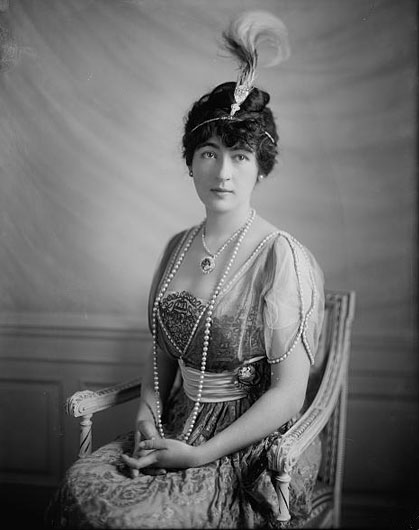 |
| In the year of her father’s death, seventy-one years after the Hope Diamond was listed in an 1839 catalog of its namesake’s gem collection, the stone was offered to, and rejected by, Leadville, Colorado, mining heiress Evalyn Walsh McLean. The setting, it seems, simply wouldn’t do. What did do was a reworking by Cartier, “with the diamond mounted as a headpiece on a three-tiered circlet of large white diamonds” (Smithsonian), as can be seen in this undated photograph of a relatively youthful Walsh McLean. Two decades later she would become embroiled in a hoax involving the Lindberg baby. (Photo: Harris & Ewing Collection, Library of Congress) |
Blue buffs will want to stay tuned for Roskin’s upcoming 10-part multimedia mini-series based on nine interviews, “The Wittelsbach-Graff and Hope Diamonds: An Evening with the Blues.”
Note: In the emailed version of our newsletter we incorrectly stated that Gary Roskin would be covering the subject of the Wittelsbach-Graff and Hope Diamonds in an upcoming Gems & Gemology. The science surrounding these diamonds will be covered, but not under a Roskin byline. We regret the error. [back to top]
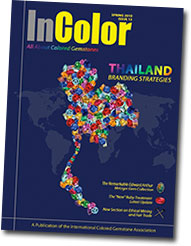 |
| Cover of the current InColor. Staff members of Pala International are occasional contributors to the quarterly. Last summer, Pala’s Jason Stephenson, with Nikolai Kouznetsov, co-authored a major overview of demantoid garnet. |
Last month saw the arrival of the latest issue of InColor, the flagship publication of the International Colored Stone Association (ICA). This expanded issue is filled with a diverse range of topics sure to excite readers and incite dialogue on important issues in the gem trade: ethical mining and fair trade, gem and jewelry branding in Thailand, a recap of the Gemstone Industry and Laboratory Conference (GILC), gemological updates, and many others.
The current issue also heralds ICA’s opening of its subscription base to non-members for a nominal yearly fee (order form on p. 46). Along with ICA and industry news, the publication continues to be a wealth of information written by notable authors, researchers, and personalities in the gem world. Past issues have featured articles by many international leading lights of the gem trade, containing in-depth, compelling articles on not just colored stones themselves, but also illuminating the adventure, history, and current issues surrounding gems. Although available for virtual browsing on the ICA website, the high-quality print version is a fine addition to one’s permanent gem and mineral library.
A feature story in the Spring 2010 issue surrounds the story and collection of Edward A. Metzger, a connoisseur collector of colored stones. (We hinted at the nature of the collection in our March 2010 story, “It’s all about the people…”.) Through the lens of Jeffrey Scovil, whose exquisite photography captures the refined nuances exhibited by this collection, readers gain a rare glimpse into a world that few have access to: a world of fabulous and exotic gems. Collecting at such a level requires not only a passion for colored stones and the financial resources to amass a diverse assemblage, but also an informed aesthetic for subtlety of color and fashioning combined with knowledge of the minerals themselves. No one appreciates this more than Bill Larson.
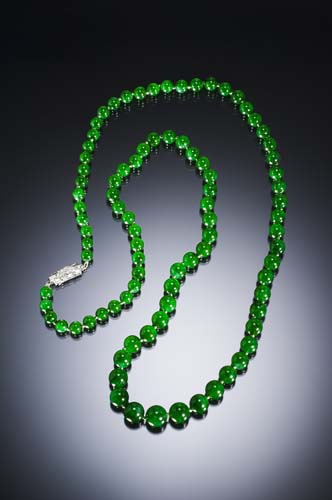 |
| I count 89… A 36-inch imperial jadeite bead necklace with beads graduated from 4.91 to 9.32 in diameter. (Photo: Jeff Scovil) |
Knowing him as one who has put together one of the nation’s finest private collections of mineral specimens and gems, Pala’s Bill Larson was one of the first people contacted by Cornell University’s Elise Skalwold, co-author of the InColor article along with Dr. William Bassett. “Through Bill Larson’s long personal experience not only as a collector himself,” she told us, ”but as a much sought after purveyor of connoisseur gems and minerals, I have a resource for curating advice, provenance (an expertise remaining to be tapped when we are both in the same hemisphere), and for insights into the mind of such a collector.” Larson’s foreword to the upcoming book about the collection will introduce this very topic.
“When I first heard of the Metzger gem collection from Elise Skalwold,” Larson told us,
I certainly wondered what it consisted of and how it was put together. Elise gave me tidbits that it was very eclectic but covered gem species from alexandrite to zircon, and was not only extensive but covered gemstones of great value, and others that cost little but illustrated gemological points. Later, when Jeff Scovil sent me photographs of many of the gemstones contained in the Metzger collection, I recognized several of them that I had seen over the years, and a few examples that Pala actually had supplied dealers in New York in the late 1990s, which later became part of the collection. So that made it more personally interesting to look into this collection.
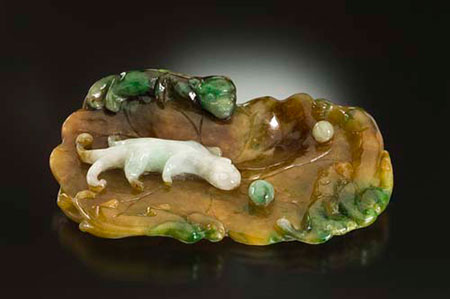 |
| Jadeite Carving. Typical of the many jade carvings in the collection; whether whimsical or historical in design, they were cherished as much as the more valuable imperial and lavender jadeite he also collected. Dimensions: 75.79 x 45.59 x 14.87 mm. Photo: Jeff Scovil |
As the InColor article tells it, Metzger came from a background steeped in aesthetics. He traveled the globe—“not only to commonly visited destinations”—ever broadening his knowledge and fascination with colored stones. In the process of building his collection he became conversant with the underlying science behind surface. As Larson became more familiar with the collection, he was struck by Metzger’s rarefied predilections.
His interests broadened into very rare gem species, and even gemstones that are only available in museum, or private, gem collections, as they are too soft to wear. I was amazed at the many fine examples he had of personal favorites of my own, such as the 10.99-carat phosphophyllite [pictured in InColor], a very beautiful but soft, rare gem from Bolivia. This was a man who did his homework and got good advice from his suppliers.
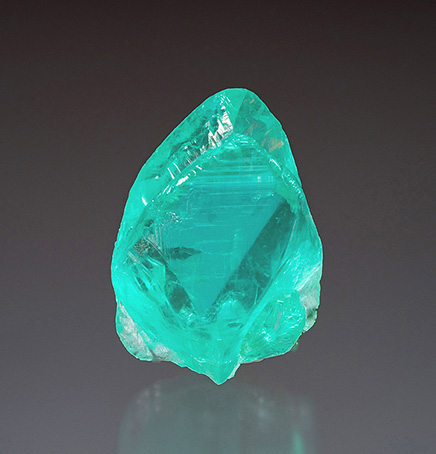 |
| From Bill Larson’s private collection. This 3.5-cm. tall phosphophyllite specimen from Bolivia, above, shows why a collector might have a “soft” spot for this rarely faceted material. A careful look shows it’s twinned, typical of the material. The specimen on matrix, below, is from the Unificada Mine in Cerro de Potosí in south-central Bolivia. It measures 61.1 x 43.1 x 34.9 mm., has a small repair, and is available for $1000. “The phosphophyllite crystals from Potosi, for size, color and quality, are by far the finest in the world,” wrote Wendell Wilson and Alfredo Petrov in Mineralogical Record (1999, 30:1). (Photos: Mia Dixon) |
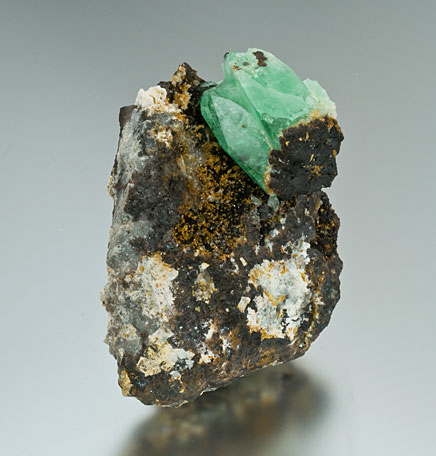 |
Two portions of the Metzger collection that are of particular interest to Pala are gems which are not widely appreciated by the general public in the West but well represented in this man’s collection. The first is Burmese jadeite. “Today with Chinese appreciation bringing jadeite’s value into the stratosphere,” Larson said, “and the embargo the USA has on jadeite from Burma, these gems are almost impossible to see in America.” The second section is that of natural pearls, about which Larson opines, “Few people in America realize just how rare non-cultured pearls are.” Even abalone pearls, in any size or shape, are rare (1 in 50,000 snails), according to dealer Wes Rankin, as referenced by Renée Newman, in her Pearl Buying Guide, which we profile below. The rarity of the abalone pearls pictured below, Elise told us, is on the order of 1 in several million. “The pearls in this necklace were collected by Lowell Jones in the 1970s and 80s along the coast of California and Lower (Baja) California and later owned by K.C. Bell.” (Bell, according to Newman, holds a Guinness World Record for his 685-carat abalone pearl.) “This suite of pearls would be nearly impossible to assemble again today,” Elise continued, “given that there are no longer any abalone large enough to produce pearls such as these, due to overfishing and other factors.”
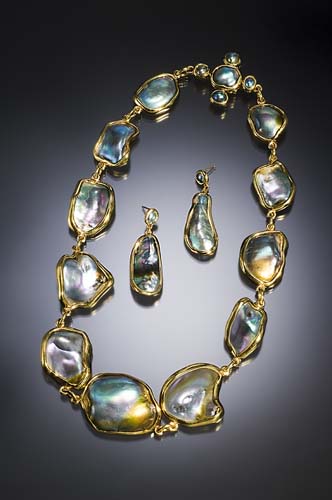 |
| The Treasure of California. The natural abalone pearls in this necklace-and-earring suite, collected decades ago, likely could not be replicated today. The largest of those pictured above measures 20.04 x 16.73 x 8.45 mm. (Photo: Jeff Scovil) |
We look forward to further developments. As always, we’ll keep you informed as the project unfolds. Meanwhile, see these related items:
[back to top]
As reports come in regarding a less than successful capping of the Deepwater Horizon oil well, we remember the heartbreak on May 8, at the failure of a 125-ton containment dome to contain the gush. Gas, leaking from the pipe, combined with cold water to form methane hydrate crystals, which clogged the steel canopy. (It was a bubble of methane gas, in fact, that burst through seals and exploded, triggering the worst offshore oil disaster in U.S. history.)
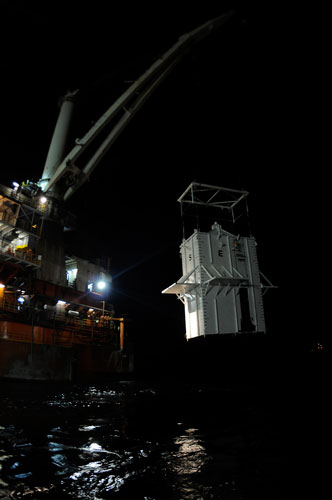 |
| Dam! This containment dome, known as a cofferdam, failed on May 8, due to formation of ice-like crystals. (Photo: U.S. Coast Guard) |
While we wrung our hands, John Koivula—a world authority on gemstone inclusions—wracked his brain. Something about those ice-like crystals might be key to a real solution—and one that could be applied to other leaks and gushers…
In the three pages of “Possible Solution to Stop the Deep Water Oil Leak at its Source,” Koivula (who has degrees in mineralogy-geology and inorganic chemistry) offers a simple and elegant solution.
“Hard science and with it hard choices have now come to our doorstep,” Koivula told us, “and original ideas are really needed. … This is not surface skimmer technology, but instead is an idea to actually plug the leak itself, right at the source.” We were skeptical, but then we read his proposal. [back to top]
 |
| Sixy. This rare, 6-rayed natural spinel from Burma weighs 2.05 carats and measures 7.75 x 6.2 x 4.11 mm. Inventory #4850. (Photo: Mia Dixon) |
Burma’s special sale was held June 25 through July 7 at the Myanmar Convention Center in Rangoon. According to the mysterious Eleven Media Group (EMG) in an undated article, about 7,000 jade lots were sold at the sale, out of 11,000 that were on offer. The unmysterious Irrawaddy, however put the number sold at 2,100 out of a total of 11,500, in its July 2 story.
Both media outlets called this the “48th” Gems Emporium, even though “special” sales held between the Annual (spring) and Mid-Year (Fall), have heretofore either been unnumbered or now number in the late 20s. See our Burma Gem Sales and Statistics for lists of the various sales.
Also, according to EMG, the annual “Mid-Year” emporium in October will be held in Nay Pyi Taw, the administrative capital, for the first time. “For the gem emporium,” the story stated, “a building that is similar to Myanmar Convention Centre is being planned to [be] construct[ed]” in the capital.
An intriguing, yet infuriating statistic regarding the June–July sale turned up in a web search the night of July 13:
Myanmar earns over 880 million USD from special gems emporium
The so-far-uncorroborated item was listed in a “Xinhua via COMTEX” listing of “News items from Asia-Pacific Desk [in Hong Kong] of Xinhua” News Agency, the official press organ of the People’s Republic of China. It was posted on Individual.com.
In a July 6 story entitled “More private companies cooperate with Myanmar gov’t in mineral extraction,“ Xinhua News Agency (XNA) included gem and jade mining block grant statistics for the past few years. (Fiscal year 2009–10 figures for jade and gem production in the article did not match those released last month by Burma”s Central Statistical Organization.)
Each block measures one acre (4,000 sq. meters) and normally are leased on a 3-year term.
Because the XNA story combines gem blocks with jade blocks it is difficult to reconcile these latest figures with those that have been reported in the past. Compare and contrast at our Burma Gem Sales and Statistics. [back to top]
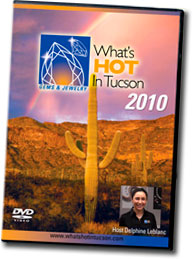 |
We’re keeping it very brief this month…
[back to top]
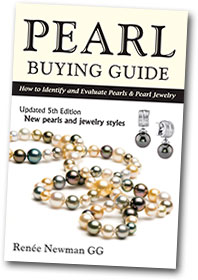 |
“One of the biggest changes in the pearl industry is an increasing interest in natural pearls from all types of mollusks—clams, scallops, snails, mussels, and Mexican oysters,” says author Renée Newman. This is reflected in the new 5th Edition of her Pearl Buying Guide. Images of melo and conch pearls from Pala International are featured in the book along with one of Pala’s natural pearls from the Mississippi river.
The first chapter has been expanded to include photos of Newman’s trip to Zhuji, China, a key area for the production and marketing of freshwater pearls. The next eight chapters visually show and explain factors that affect pearl pricing—shape, luster, nacre thickness, color, surface quality, size, make, and pearl type. The next seven chapters discuss and illustrate South Sea pearls, black pearls, freshwater pearls, treatments, imitations, and antique pearl jewelry. Readers interested in recent lab reports that discuss the wiggly world of natural-vs.-cultured (see last month’s Research Roundup) will find Chapter 15 of relevance; it contains tests for the layperson who still has that x-ray micro computed tomography unit on layaway.
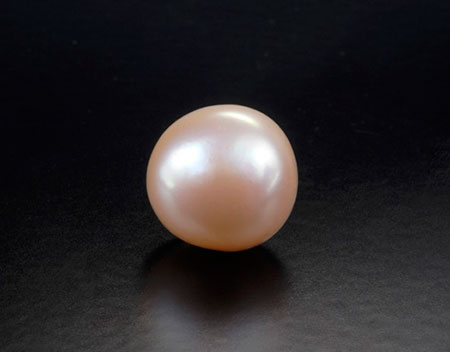 |
| Natural pearl from the Mississippi River, 16.84 carats, 14 mm. Its lack of a perfectly round shape is an indicator of its pedigree, as Newman points out in Chapter 15 of the book. (Pearl: Pala International; Photo: Wimon Manorotkul) |
Practical guidelines for buyers and sellers of pearls are offered in the final chapters on choosing the clasp, versatile ways to wear a strand of pearls, creating unique pearl jewelry with colored gems, and caring for your pearls. In total, there are 207 new photos showing new pearls and jewelry styles in this revised edition as well as updates on treatments, geographic sources and GIA pearl grading.
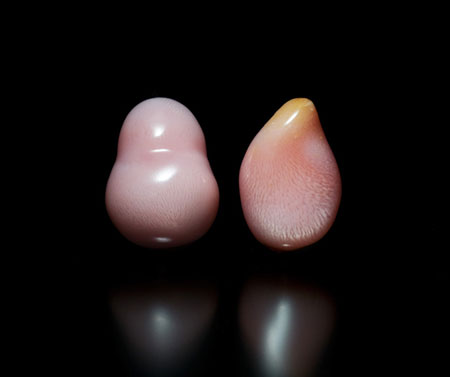 |
| Conch pearls with flame pattern. (Pearls: Pala International; Photo: Mia Dixon) |
The Pearl Buying Guide was first published in 1992 in response to requests for a practical guide on evaluating, identifying, and selecting pearls. Since then it has been used as a text for pearl courses, a training manual for sales staff, a resource for designers, and an aid to buying pearls. The 153-page book can be purchased at major bookstores and jewelry supply stores, or via the link on the author’s website.
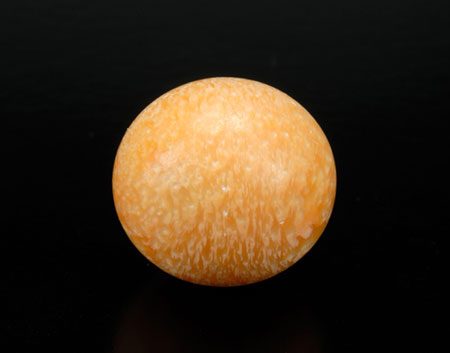 |
| Melo pearls with flame pattern. Above, 37.88 carats, with distinct flame pattern. Below, 75.07 carats. (Pearls: Pala International; Photos: Mia Dixon) |
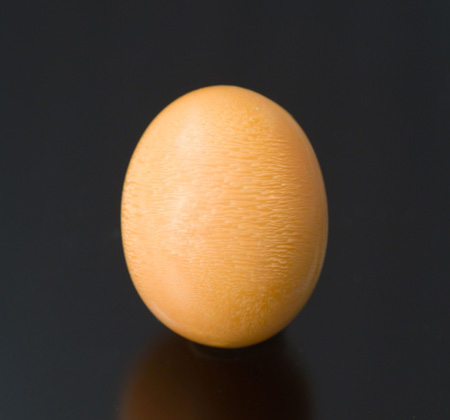 |
[back to top]
 |
…you owe it to yourself to see I Am Love (Io sono l’amore), the film by director Luca Guadagnino currently in theaters, featuring the always compelling Tilda Swinton, the well-cast Marisa Berenson, and a superb Italian ensemble.
A suite of achingly lustrous pearls makes (to mix a metaphor) a cameo appearance at the climax of this splendid work of art. As one critic wrote, “See it by any means possible”—as long as it’s on the Big Screen.
 |
Pearls abound—strand after strand, yard after yard—in Coco Chanel & Igor Stravinsky, Jan Kounen’s film adaptation of a Chris Greenhalgh novel.
The film stars Anna Mouglalis, for eight years the official Chanel spokesmodel, having been installed by Coco Chanel’s design heir, Karl Lagerfeld, who contributed the black sequined gown that Mouglalis/ Chanel wears for a final scene. The gown’s sheer neckline is overlain with an arresting necklace that appears to be composed of a narrow band of diamond baguettes atop two or three oscillating strands of what at first glance might be mistaken for seed pearls but are likely mélée diamonds. (Journalist Lorenza Muñoz, in the preface to an interview with Kounen, calls the necklace “diamond.”)
We’d suggest avoiding previews of either film, especially for Coco & Igor, which gives new meaning to the term “trailer trash.” [back to top]
— End July Newsletter • Published 7/18/10 —
Pala International heads to the East Coast later this summer for the trade-only JA New York Summer Show. Stop by to see one of America’s largest selections of fine colored gems.
 |
When: July 25–July 28, 2010
Where: Jacob K. Javits Convention Center
Hours: AGTA Gemstone Section
Sunday, July 25: 9:30 AM – 6:00 PM
Monday, July 26: 10:00 AM – 6:00 PM
Tuesday, July 27: 10:00 AM – 6:00 PM
Wednesday, July 28: 10:00 AM – 3:00 PM
Pala International is in booth 1671. See the JANY website for more information. Visit the Pala International Show Schedule for future events. [back to top]
Pala International’s Bill Larson, Will Larson, Carl Larson, and friend and fellow gem dealer Mark Kaufman will attend this event this year, held in the midst of the Alsace wine region of northeastern France.
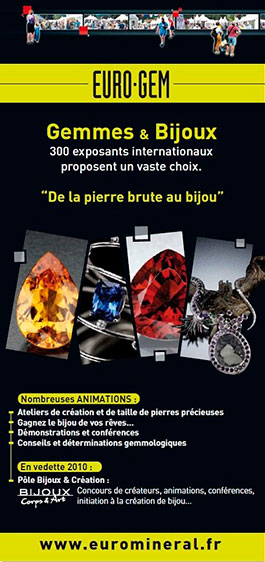 |
See Bill’s report and Will’s report from the 2009 show to get a taste.
The Euro-Gem theme this year is “De la pierre brute au bijou” (From rough stone to jewel). Three hundred gem and jewelry exhibitors are featured. See designers in their studios and laboratory gemologists.
What: Euro-Mineral/Euro-Gem
When: June 24–27, 2010
Where: Sainte-Marie-aux-Mines, France
We look forward to seeing you there. [back to top]
This month we feature a pair of Mozambique paraiba tourmalines par excellence.
These two beauties were swimming around solo in our inventory for a couple of years until we realized they made a stunning matched pair. As our stock of fine paraibas from Mozambique has dwindled, these seem to find a common bond in size, shape, and that fluorescent glow we come to recognize with these copper-bearing tourmalines.
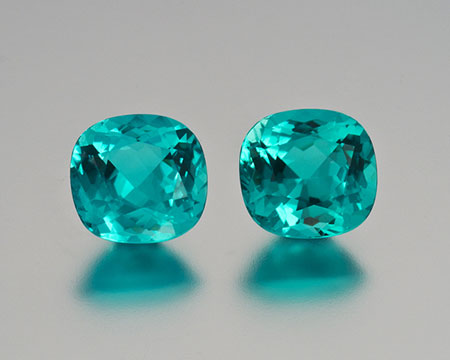 |
| Bonded: Paraiba tourmaline from Mozambique; right, 6.0 carats, 11.35 x 10.71 x 7.47 mm.; left, 5.53 carats, 11.23 x 10.81 x 7.04 mm. (Photo: Mia Dixon) |
Right along with our stock, the actual deposit in Mozambique has been drying up quickly. Numerous sources report only small, included pieces of rough being found on the outskirts of the main paraiba ore lens. Just as Mother Nature assembled this particular variety of tourmaline into a small deposit, we have brought together two of the finest paraibas in a gorgeous bond.
See our selection of paraibas here. Read more about the Mozambique deposit here.
As we announced in our June 10 press release, Palaminerals.com is now open for business and browsing.
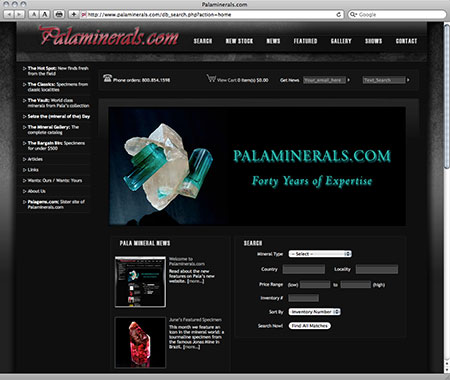 |
For a list of features on the new site, see this news item. [back to top]
Some research reports of note from recent weeks…
Gübelin Gem Lab, it its Newsletter #30, states: “With 80+ years of experience testing the world’s most unique gemstones and jewellery, the Gubelin lab is pretty hard to impress.” Impressed it was by two items that were subsequently written up for Gems & Gemology’s Spring 2010 “Gem News International” section.
The first was a 41.54-carat brownish greenish yellow brilliant-cut diamond, which revealed a cuboid phantom cloud, remarkably visible via optical microscopy. High concentrations of hydrogen are typically responsible for such a growth. Not only is the growth of interest, but the stone itself is thought to be the second largest of its kind, after the 61-carat “Eye of the Tiger.”
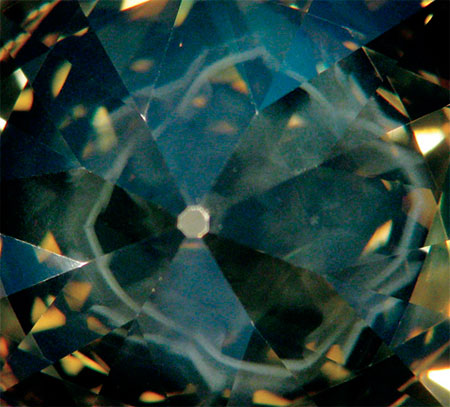 |
| Cuboid cloud. A 5-mm.-wide phantom cloud is clearly visible using dark-field illumination. (Photomicrograph: Pierre Hardy, Gübelin Gem Lab) |
The second unusual item—while not really relevant to Research Roundup—was a decorative prayer rug made of 27,104 gemstones with a reported total carat weight of greater than 14,000, plus just under 16 kg. of 18-karat gold. Owner Kathryn Bonanno told the lab that the tapestry, which is of a 1980s–1990s French vintage, took ten years for cutting and assembly. Diamonds, emeralds, rubies, and blue, pink and yellow sapphires were employed. [back to top]
GAAJ-ZENHOKYO has overhauled its website—a welcome move—but now requires free login to access research reports. No biggie…
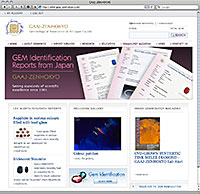 |
With “Sapphire in various colours filled with lead-glass,” GAAJ adds to the volume of reporting on the subject of glass filling. The lab saw, for the first time in its experience, sapphires in various color—pink, pale green, pale yeloow, and colorless—set in a necklace. This differed from treated material previously examined: ruby, black star sapphire, and blue sapphire.
Magnification revealed flash effect (except in the colorless pieces) and flattened glass bubbles. One of the new website’s click-and-zoom photomicrographs (see figure 2) reveals a spectacular view of both indicators. (For more eye candy, visit the site’s Inclusions Gallery.) Compositional and x-ray radiographical analysis confirmed the presence of lead and the extent of glass distribution.
If the former report has an air of familiarity about it, “Iridescent Nuumite” is a bit more exotic. The trade name, Nuummite, means “derived from Nuuk” in Greenlandic, owing to its discovery near the commune by that name in southwestern Greenland. It is a mixture of two orthoamphibole group minerals, anthophyllite and gedrite, and the irridescent material, according to GAAJ, can be found in New England and, more recently in Mauritania. It’s this latter material that was studied by GAAJ.
Because amphibole is a major rock-forming mineral group, its chemical composition has a wide range. According to the report, more than 60 varieties are known; thus ordinary gemological testing for identification gave way to laboratory techniques, which are described along with the findings.
Gems & Gemology mentions of nuumite are listed here. GAAJ claims that the first gemological report on the stone was on a “new gem material from Greenland” in G&G in 1987 (Vol. 23, No. 1, pp. 36–42). But the material is described as “the oldest mineral in existence” by metaphysicians, amongst whom the stone appears to be quite popular. [back to top]
Both Gemlab and SSEF last month issued reports on cultured pearls masquerading as natural. As the demand for natural pearls has grown, large quantities of pearls purported to be natural have been sent to the labs for certification. They are characterized by a perfect appearance outside and by the absence of any structure under radiography, or by an internal structure that is convincing—or at least confusing.
One theory is that cultured pearls are being bought in quantity and then x-rayed; those that pass the test are then marketed as natural. Such a situation poses challenges for the labs, and SSEF and Gemlab take you through cutting-edge technical methodology in order to make determinations. Sometimes the conclusion is impossible, but the development of new identification techniques is on a parallel path with the designs of those who would want to outsmart the detectives. See:
[back to top]
If you ever have a need to select gemstone types by refractive index or basic color, RealGems.org is your reference. Other sections of the site cover gemstone deposits, gemstone terms, crystal systems, institutions, museums, and links.
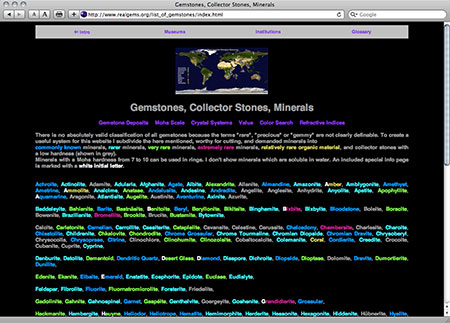 |
| Rank and file. Gems and minerals are listed using a color-coding system that signifies the rarity of the material, from common (blue) to extremely rare (shocking pink). |
As the proprietor states on the home page, “No sales, no purchases, nothing in stock, only for information purposes.”
Launched last June, the site has had contributions of nearly 4,000 images from 165 gem dealers, collectors, and institutions. [back to top]
Note: The following press release was issued by the law firm of Greene Broillet & Wheeler, LLP, on May 6, 2010. The complexity of the case is demonstrated by its title, in boldface below, which involves seven named parties in two filings.
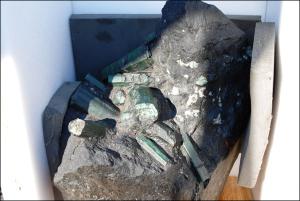 |
| Languishing in jail. “Bahia” Emerald gets its day in court. (Photo: L.A. County Sheriff) |
LOS ANGELES--(BUSINESS WIRE)--Today, Los Angeles Superior Court Judge John A. Kronstadt ordered a new trial date in the dispute over who owns the Bahia Emerald, which at 840 pounds is said to be the world’s largest raw emerald. The trial, originally scheduled to begin on May 10, 2010, has now been set for July 12, 2010. Until the dispute is resolved, the Bahia Emerald remains in custody with the Los Angeles Sheriff’s Department. [Case title:] Ken Conetto By Eric Kitchen His Attorney In Fact (Petitioner) vs. Kit Morrison and Todd Armstrong (Respondents); Mark Downie (Intervenors) vs. Eric Kitchen et al., Kit Morrison and Todd Armstrong (Respondents), Case No. BS118649.
Respondents Kit Morrison, Todd Armstrong, Jerry Ferrara, FM Holdings, Inc. and Market Link, Inc. contend that they have legal title to the Bahia Emerald. They also claim that they have an equitable claim to title as bona fide purchasers of the Bahia Emerald based on their payment of $1.3 million based for the Bahia Emerald.
Browne Greene with the Santa Monica, CA, law firm of Greene Broillet & Wheeler (www.greene-broillet.com) and Daniel K. Balaban and Andrew J. Spielberger with the Santa Monica, CA, law firm of Balaban & Spielberger (www.balaban-spielberger.com) represent Respondents Kit Morrison, Todd Armstrong, Jerry Ferrara, FM Holdings, Inc., and Market Link, Inc.
For background on the case, see:
[back to top]
 |
| Spinel. The only stone to show increased production last year. This orange-pink variety is a scrumptious example. Inventory #18049. (Photo: Mia Dixon) |
Total gemstone production in Burma declined for the second straight year and, compared with Fiscal Year 2005–06, was down by 60 percent. Only two statistical sectors saw increases: spinel and pearls.
For the actual figures, see Pala’s Burma Gem Sales and Statistics. [back to top]
Burma is slated to hold a special gems emporium in Yangon sometime in late June through early July, according to a May 17 story by Xinhua News Agency. The auction will be held in the Myanmar Convention Center.
Sources quoted by Xinhua stated that the 47th Annual Myanma Gems Emporium held in March garnered over €400 million, or $496 million, from the sale of “nearly 7,000 jade lots and gems.”
Last year’s spring auction brought in $191 million, but the figure was attributed to jade sales only, by Associated Press.
 |
| Stella luna. Like a midsummer blue moon (by any definition), this star peridot is quite rare, yet affordable. The 4.31-ct round cab from Burma displays a 4-rayed star and floating light. Inventory #14836. (Photo: Mia Dixon) |
[back to top]
[back to top]
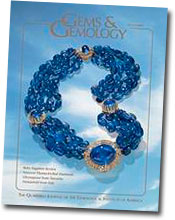 |
We had planned to serve up a helping of Gems & Gemology ourselves on Palagems.com, but AGTA’s ePrism beat us to it yesterday. “Ruby and Sapphire Markets Transformed” is adapted by Russell Shor from his and Robert Weldon’s cover article from the Winter 2009 issue, and is posted on the ePrism archive.
The transformation mentioned in the title is multifaceted, with different factors affecting ruby versus sapphire. The article provides an overview of the history and brings us up to date, looking towards factors such as consumer demand for fair-trade and socially responsible product, and skepticism regarding treatments.
Now that we’ve gotten your attention… Sapphire is being tested as an information-relaying sensor in the process of converting coal to a gas, known as gasification, according to a May 11 article in Discovery News, the cable channel’s online news outlet. The process allows coal to up its efficiency from 35 percent to 45+ percent, but because this involves high pressure, high temperature, and chemical reactions, things can get out of control. A sensor that keeps tabs on the volatile process is needed, but what can withstand 3000-degree F heat?
Sapphire. Still in the experimental stage, sensors are being constructed from sapphire fibers by Missouri University of Science and Technology associate professor Hai Xiao and colleagues. Read the full story at Discovery News and Missouri S&T.
 |
| Sensor fodder? This heavily zoned sapphire, possibly untreated from Ceylon, doesn’t deserve to be experimented upon by a Midwestern university laboratory. Save her! Inventory #10372. (Photo: Mia Dixon) |
[back to top]
— End June Newsletter • Published 6/17/10 —
 |
It’s almost time to for the JCK Las Vegas show. Pala International will be there in force, with one of America’s largest selections of fine colored gems.
Note: The JCK Show this year runs Friday through Monday. The AGTA Pavilion still opens one day early—Thursday, June 3—before the main JCK Show.
When: June 3–7, 2010
Where: Venetian Hotel Grand Ballroom adjacent to the Sands Expo & Convention Center, Las Vegas, NV
Hours: AGTA Gemstone Section
Thursday, June 3: 10:00 AM – 6:00 PM
Friday, June 4 to Sunday, June 6:
9:30 AM – 6:00 PM
Monday, June 7: 9:30 AM – 4:00 PM
Booth: AGTA Pavilion, booth 34308
See also this notice from AGTA about the GemFair. We look forward to seeing our many friends there. Visit the Pala International Show Schedule for future events. [back to top]
Pala International’s Bill Larson, Will Larson, Carl Larson, and friend and fellow gem dealer Mark Kaufman will attend this event this year, held in the midst of the Alsace wine region of northeastern France.
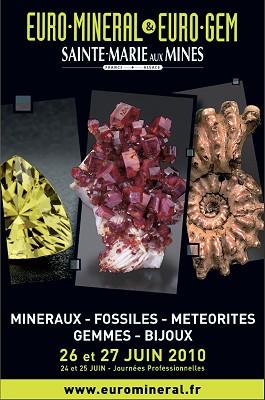 |
See Bill’s report from the 2009 show to get a taste. The Euro-Gem theme this year is “De la pierre brute au bijou” (From rough stone to jewel). L’Espace Prestige in the Theatre will feature a Mineral Treasury of Slovenia, specimens from La Gardette Mine (famous for quartz), Mineralogy in Brittany, and Minerals and Philately—a Combined Passion.
What: Euro-Mineral/Euro-Gem
When: June 24–27, 2010
Where: Sainte-Marie-aux-Mines, France
We look forward to seeing you there.
 |
| Axinite from Bourg d’Oisans, site of La Gardette Mine. This specimen is available, Inventory #8135. (Photo: John McLean) |
[back to top]
 |
| Photo: Gary Roskin |
Sainte-Marie-aux-Mines isn’t the only European venue of note, of course. Baselworld, The World Watch and Jewellery Show, also attracts a huge following.
Gary Roskin, of The Roskin Gem News Report, was there in March. Many factors affect attendance and business at these shows, and Roskin captures the ups and downs. See the report here. (It will be archived here.)
Roskin told us to be on the watch in the next few days for his own look at Mozambique ruby, which we cover below. [back to top]
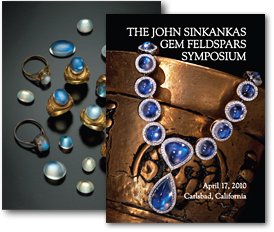 |
The eighth annual symposium in honor of John Sinkankas took place April 17 at the Gemological Institute of America (GIA) in Carlsbad, CA. The theme of the symposium was “Gem Feldspars.” Co-hosted by GIA and the San Diego Mineral and Gem Society, the sold-out event was attended by 144 people.
A full day of days of talks on gem feldspars covered everything from photographic exploration to mineralogy to color, and finished with a comprehensive analysis of the red/green andesine from China by Dr. George Rossman. Much of the material covered was presented in a full-color handout. The handout is available from the Symposium website, which also lists the table of contents.
 |
| Moonstone. The photograph by Wimon Manorotkul above, of Pala International’s adularescent moonstone, is included on the 2010 Sinkankas Symposium website. It is no longer available, but the stone pictured below, Inv. #11465, was added last week by Pala photographer Mia Dixon to our Old Stock… New Pix. Look elsewhere in this edition of Gem News for a stunning photo by Mia. |
 |
[back to top]
This month we feature an unexpected tourmaline from Mozambique. Along with the discovery of paraiba-type tourmaline, and the amazing spectrum of neon colors, a few other unique colors have surfaced as well. This golden tourmaline exhibits a dominantly yellow hue with a kiss of orange. A gemologist may even be puzzled to site-ID this gem, which hints at chrysoberyl, golden beryl, sapphire, and zircon. A chameleon of sorts for the inquisitive eye of a collector. A perfect jewel, precisely faceted, to round out a tourmaline collection or as a centerpiece for a one-of-a-kind design.
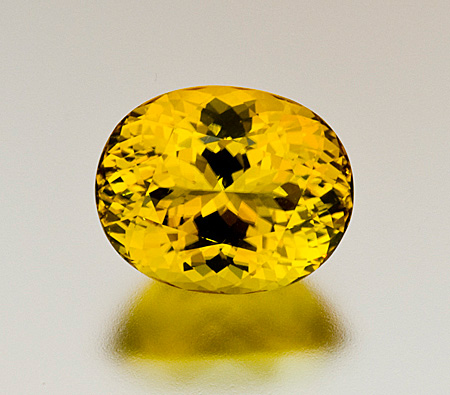 |
| Golden tourmaline from Mozambique, 11.19 carats, 15.01 x 12.08 x 9.31 mm., Inventory #15868. (Photo: Jason Stephenson) |
See other tourmalines from Mozambique:
Interested? Select the inventory number above, call, or email us to inquire. [back to top]
This spring, Gems & Jewellery, the periodical of The Gemmological Association of Great Britain (Gem-A), published its seasonal issue featuring a fantastic horsetail inclusion in a demantoid garnet from Russia. The photo was taken by Pala’s own Mia Dixon, who has been honing her photographic skills with the company for the past two years. The diverse subject matter of Pala’s gems and unusual variety of mineral specimens demands intuition and creativity to capture the plethora of color and complexity.
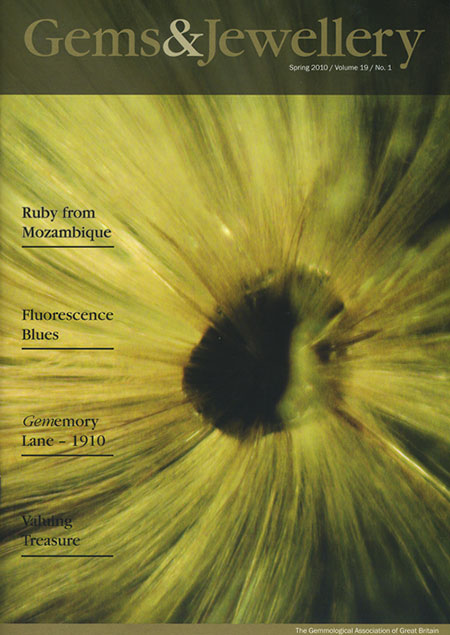 |
This featured demantoid is actually in Pala’s inventory right now. You could own a published jewel!
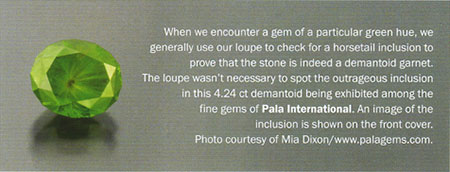 |
[back to top]
The Montepuez ruby deposit, first discovered in spring of 2009, started producing many rubies that made their way in to Gemological Institute of America (GIA) laboratories in Bangkok as well as other labs. Many natural rubies showed up first, but they were quickly followed by treated ones. The treated rubies were initially described being similar to the Mong Hsu rubies from Burma in that they were found to be flux heated with healed fissures or flux-assisted partial-fissure-healing (FAPFH). Upon further investigation these new rubies were also found to have glass filled fissures (GFF). No lead or bismuth was found in the fissures—if there were they would be classified as lead glass filled fissures (LGFF)—but the presence of glass still puts this material into a much less desirable category with durability issues. Application of heat, chemicals, or simple abrasion by a jeweler, dealer, or consumer can affect the integrity of the ruby, creating a need for full disclosure of treatments.* This need resulted in new nomenclature by GIA in March of 2010, disclosing a combination of healed and filled fissures, no matter what the origin.
*Because it is a poison, lead in LGFF also raises safety concerns, but not to the wearer. Jewelers that use a torch on material containing lead may be at risk. Obviously such a safety concern warrants adequate disclosure.
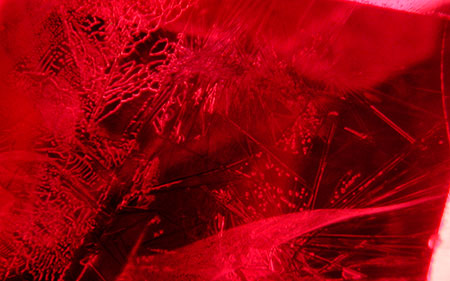 |
| Glass filled and healed fissure in Mozambique ruby. According to Vincent Pardieu of GIA Laboratory Bangkok, who took this photomicrograph (40x magnification, dark field illumination; larger view here), the hair-like curved vertical line on the upper right side indicates where this ruby’s fissure meets the surface of the stone. The line’s unbroken appearance means that the fissure is not healed. Just below the surface the fissure is filled and it is possible to see devitrification features (straight, needle-like lines) and small round features (gas bubbles). Deeper inside the fissure, on the left side, the fingerprint- and honeycomb-like figures indicate where some healing took place. See Figure 11 of the lab’s report for another view of these features. (Photo: Vincent Pardieu, GIA Laboratory Bangkok) |
American Gemological Laboratories (AGL) also looked at the ruby treatment. Because of the absence of lead, AGL likened the treatment to that of “glass-filled” rubies seen in the early-to-mid-1990s.
Glass filling was first reported in Thai/Cambodian ruby and sapphire in the early 1980s, followed by rubies coming out of the Morogoro region of Tanzania and to a lesser extent from Mogok, Burma. In the early 1990s translucent Mong Hsu ruby rough from Burma was transformed into transparent gems through the FAPFH process. Temperatures up to 1850° C and molten flux allowed for the ruby surfaces (alumina) and fissures to recrystallize, incorporating the flux to create an enhanced clarity leaving partially healed fissures.
By 2004 a new batch of LGFF had been identified from Andilamena, Madagascar. This material had good shape and color, but was heavily fissured, leaving openings for the glass filling. The discovery of ruby in Winza, Tanzania in 2007 was followed by two new deposits in Mozambique: Niassa in 2008 and Montepuez in 2009. It turned out that the best unheated ruby was coming from Niassa, but the bulk of the rough was being treated by LGFF. The Montepuez material was mainly being treated by the FAPFH process with a mixture of borax and silica.
Main difference between FAPFH and LGFF/GFF:
See the following reports and news releases.
For more information on ruby from Mozambique, see
[back to top]
Last weekend, microWorld of Gems unveiled its new and streamlined website. The classic volumes, The Photoatlas of Inclusions in Gemstones, Vols. 1, 2, and 3 are now available for purchase from the source with the convenience of PayPal. A purchase of all three volumes can save the savvy shopper $100.
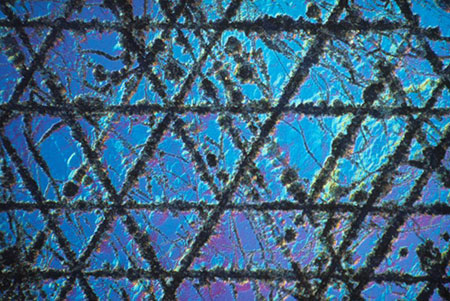 |
| Lamellar twinning on a sapphire, 40x magnification. (Photomicrograph © microWorld of Gems) |
Volume 3, released in 2008, was the culmination of a remarkable collaboration between the series’ authors John I. Koivula and Dr. Eduard J. Gübelin. “With a combined total over 5,500 photomicrographs,” an announcement stated, ”each book builds upon the next without duplicating information.”
Signed copies of the book also will be available for purchase at the Las Vegas show, Friday, June 4, between 11 a.m. and 2 p.m., at the National Association of Jewelry Appraisers Booth L51. [back to top]
 |
| Last edition of our Gem News we said “we’re not in the diamond trade,” but we now offer three nice diamond crystals, two of which are pictured here: a natural 10.82-carat octahedron above, featuring etched trigons on all faces, and a 3.30-carat natural greenish crystal in a macle-twin habit. See all three here. (Photos: Jason Stephenson) |
 |
Recent articles in Canada’s Financial Post regarding the country’s diamond mining paint a picture of a booming industry. According to an undated Post clipping forwarded to Pala, gem-diamond production in 1995 was at zero. As of 2009, Canada accounted for 13% of tracked global production, according to the 2010 U.S. Geological Survey “Mineral Commodity Summaries, January 2010 – Gemstones.” And that’s down from 17–19% in 2008, depending on which year’s reports you read.
A March 23 Post article profiled what will become Canada’s fifth operating mine, a few dozen miles to the west of Lac Nichicun, in central Quebec’s Otish Mountains. The operator estimates a 25-year life span for the site, with a total output of 30 million carats. (A previous estimate had pegged the life at 7 years.)
With the opening of the new mine, which still requires a feasibility study, the nation’s diamond industry is in step with Canada’s motto, A Mari Usque Ad Mare, “From Sea to Sea.” (Other mines are or were situated in Northwest Territories, Ontario, and Nunavut.)
The clipping claimed that the diamond industry has “provided considerable benefits for Canada’s northern and Aboriginal communities,” with $10+ billion in capital and operating expenses devoted to the Northwest Territories. Education, trade training, and Aboriginal employment partnerships also have been created, the clipping stated. Between 1991 and 2007, unemployment dropped 8% while the region’s GDP swelled nearly threefold. Between 1995 and 2007, high school graduation rose 23% and the percentage of people on welfare fell 7%. [back to top]
 |
Last spring we looked at Renée Newman’s third edition of her Ruby, Sapphire & Emerald Guide. The prolific author has followed up a year later with Volume 1 of a series entitled Exotic Gems, which focuses on a group of lesser known gemstones.
Author and gemologist Newman credits television shopping networks with introducing the public to gemstones such as rhodochrosite and diaspore—material that wasn’t often used in jewelry—as well as creating a market for information, which she provides.
Newman begins Chapter 1 of the book by explaining that the term “exotic” can mean unusual, if not not always foreign, so that ammolite from from northern Alberta may still be considered exotic to Canadians, even if it is domestic. Chapters 2 and 3 provide an overview of the factors that affect price: the Cs (color, clarity, cutting style and shape, cut quality, carat weight), transparency, treatment, brilliance, brand, and phenomena. Chapter 4 follows with definitions of gemstone identification terms.
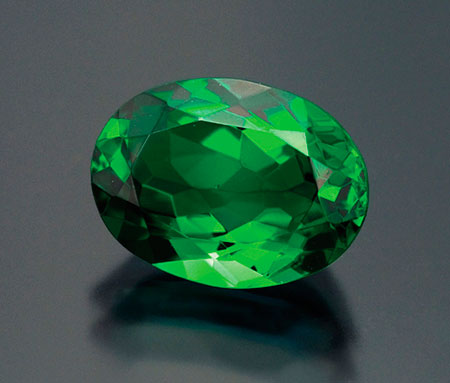 |
| Several of the photographs in Renée Newman’s Exotic Gems come from Pala International, including this 5.45-carat green tanzanite. (Photo: Wimon Manorotkul) |
Then on to the stones themselves, beginning with tanzanite in Chapter 5. Having issued a book in 1996 on emerald and tanzanite—now out of print—Newman gives a new life in these pages to what is probably the most famous of the Volume 1 group. (Emerald was revived by Newman, in turn, in last spring’s Ruby, Sapphire & Emerald Guide.) History and geographic sources are explored; also nomenclature (tanzanite is a variety of zoisite). Treatment is highlighted, since tanzanite is almost always heated; other treatments also are discussed. Pleochroism and lighting both are nicely illustrated. (Did we mention that the book features nearly 300 color photographs?)
Metaphysical lore is covered in the book for nearly every type of gemstone presented—even tanzanite, which is a relatively recent discovery. Identifying characteristics are summarized in a convenient table, accompanied by several photos. Price factors—including two examples of recutting—and care of tanzanite round out the chapter, and provide a pattern for those that follow.
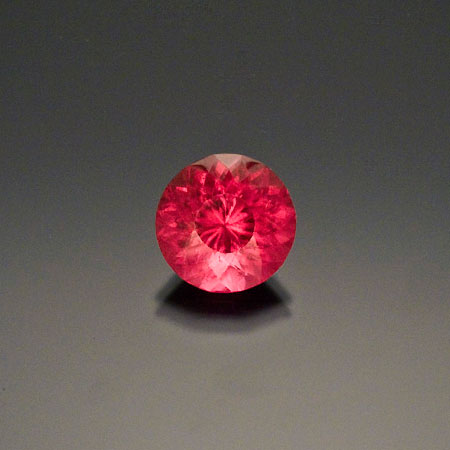 |
| Also from Exotic Gems. This 19.78-carat round brilliant rhodochrosite above was Pala International’s featured gemstone for January 2009. No longer available, it came from Alma, Colorado. (Photo: Jason Stephenson) The Peruvian rhodochrosites below, 6.22 and 6.51, show the variety of hue to be found in the gemstone. (Photo: Mia Dixon) |
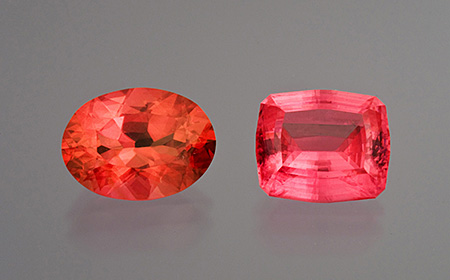 |
Chapter 6, on zultanite (aka gem-quality, color-change diaspore), while omitting any mention of lore, does feature a four-page pictorial on cutting the variety by master cutter Stephen Kotlowski. Lots of lore is included for ammolite in Chapter 7, as one look at the material in matrix would suggest—the iridescent gem having been formed within the fossilized mollusk ammonite. Rhodochrosite, while surely being familiar to our readers, is beautifully illustrated in Chapter 8, with 18 photos showing this gemstone’s many manifestations.
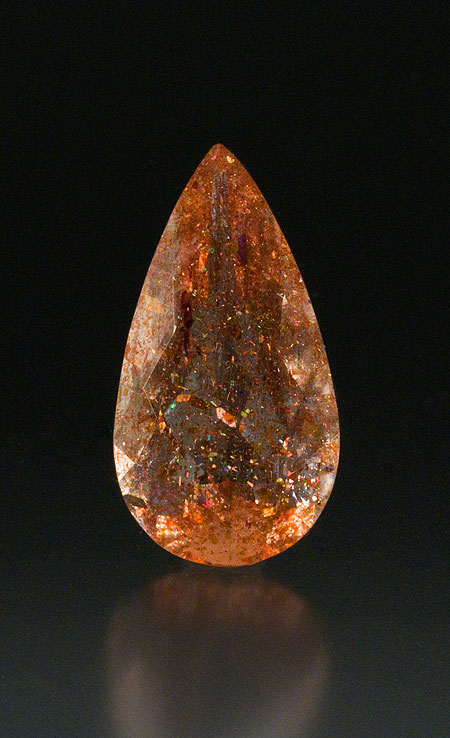 |
| Also included in Exotic Gems. This 20.37-carat sunstone, above, from Arusha, Tanzania is still available, Inventory #17383. (Photo: Mia Dixon) A photomicrograph, below, from another Tanzanian sunstone, shows randomly oriented hematite platelets. (Photo: Wimon Manorotkul) |
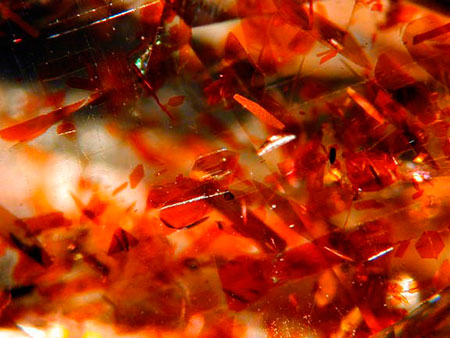 |
Chapters 9 through 12 cover the feldspar group—sunstone, moonstone, and the rest—and these four well-illustrated chapters nicely guide the reader through territory that sometimes can be a little daunting. The inclusion of H. A. Hänni’s feldspar-triangle chart should be useful in that regard, with photos of the varieties themselves illustrating the edges.
Newman closes the book with a chapter, 13, reminding us that even with the information provided in her pages, a qualified appraiser could be a gem buyer’s best friend, especially in the case of a purchase of any significance. A three-page bibliography also is included.
You’ll be surprised how much useful information can be poured into 154 pages—and don’t miss the lovely inside covers. The book can be purchased at major bookstores and jewelry supply stores, or via the link on the author’s website. [back to top]
— End May Newsletter • Published 5/18/10 —
2015.3 | 2015.2 | 2015.1
2014.3 | 2014.2 | 2014.1 | 2013.3 | 2013.2 | 2013.1 | 2012.3 | 2012.2 | 2012.1
2011.3 | 2011.2 | 2011.1 | 2010.3 | 2010.2 | 2010.1 | 2009.3 | 2009.2 | 2009.1
2008.3 | 2008.2 | 2008.1 | 2007.3 | 2007.2 | 2007.1 | 2006.3 | 2006.2 | 2006.1
2005 | 2004 | 2003 | 2002 | 2001 | 2000
Note: Palagems.com selects much of its material in the interest of fostering a stimulating discourse on the topics of gems, gemology, and the gemstone industry. Therefore the opinions expressed here are not necessarily those held by the proprietors of Palagems.com. We welcome your feedback.